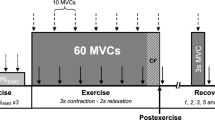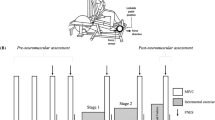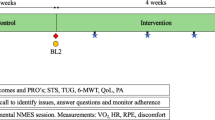Abstract
Purpose
Cancer-related fatigue (CRF) is the most reported side effect of cancer and its treatments. Mechanisms of CRF are multidimensional, including neuromuscular alterations leading to decreased muscle strength and endurance (i.e., fatigability). Recently, exercise fatigability and CRF have been related, while fatigability mechanisms remain unclear. Traditionally, fatigability is assessed from maximal voluntary contractions (MVC) decrease, but some authors hypothesized that the rate of force development (RFD) determined during a rapid contraction could also be an interesting indicator of functional alterations. However, to our knowledge, no study investigated RFD in cancer patients. The purpose of this study was to determine whether RFD, fatigability amplitude, and etiology are different between fatigued and non-fatigued cancer patients.
Methods
Eighteen participants with cancer, divided in fatigued or non-fatigued groups according their CRF level, completed a 5-min all-out exercise in ankle plantar flexor muscles composed of 62 isometric MVC of 4 s with 1 s rest, to assess fatigability amplitude as the force–time relationship asymptote (FA). Before and after exercise, fatigability etiologies (i.e., voluntary activation (VA) and evoked forces by electrical stimulation (Db100)) were assessed as well as RFD in 50 and 100 ms (RFD50 and RFD100, respectively) during rapid contractions.
Results
FA is significantly lower in fatigued group. Significant differences were found between pre- and post-exercise VA, Db100, RFD50, and RFD100 for both groups, with no statistical difference between groups.
Conclusion
During treatments, fatigability is higher in fatigued patients; however, the mechanisms of fatigability and RFD alterations are similar in both groups.
Trial registration
ClinicalTrials.gov, NCT04391543, May 2020.




Similar content being viewed by others
Data availability
The datasets generated and analyzed during the current study are available from the corresponding author on reasonable request.
Abbreviations
- ANOVA:
-
Analysis of variance
- BMI:
-
Body mass index
- CAR:
-
Central activation ratio
- CRF:
-
Cancer-related fatigue
- Db10 :
-
10-Hz doublet electrical stimulation
- Db100 :
-
100-Hz doublet electrical stimulation
- EORTC:
-
European Organization for Research and Treatment of Cancer
- F A :
-
Force–time relationship asymptote
- F peak :
-
Peak force occurring during a muscular contraction
- FS:
-
Force when the superimposed electrical stimulation was applied
- MVC:
-
Maximal voluntary contraction
- RFD:
-
Rate of force development
- SD:
-
Standard deviation
- ST:
-
Difference between the force produced during a maximal voluntary contraction and the force induced by a superimposed electrical stimulation applied on this later
- VA:
-
Voluntary activation
References
Aagaard P, Simonsen EB, Andersen JL, Magnusson P, Dyhre-Poulsen P (2002) Increased rate of force development and neural drive of human skeletal muscle following resistance training. J Appl Physiol 93(4):1318–1326. https://doi.org/10.1152/japplphysiol.00283.2002
Abdalla LHP, Denadai BS, Bassan NM, Greco CC (2018) Exercise tolerance during muscle contractions below and above the critical torque in different muscle groups. Appl Physiol Nutr Metab 43(2):174–179. https://doi.org/10.1139/apnm-2017-0381
Berger AM, Mooney K, Alvarez-Perez A, Breitbart WS, Carpenter KM, Cella D, National comprehensive cancer network (2015) Cancer-related fatigue, version 2.2015. J Natl Compr Cancer Netw 13(8):1012–1039. https://doi.org/10.6004/jnccn.2015.0122
Boccia G, Dardanello D, Brustio PR, Tarperi C, Festa L, Zoppirolli C, Rainoldi A (2018) Neuromuscular fatigue does not impair the rate of force development in ballistic contractions of submaximal amplitudes. Front Physiol 9:1503. https://doi.org/10.3389/fphys.2018.01503
Bower JE (2014) Cancer-related fatigue–mechanisms, risk factors, and treatments. Nat Rev Clin Oncol 11(10):597–609. https://doi.org/10.1038/nrclinonc.2014.127
Bower JE, Ganz PA, Irwin MR, Cole SW, Garet D, Petersen L, Crespi CM (2021) Do all patients with cancer experience fatigue? A longitudinal study of fatigue trajectories in women with breast cancer. Cancer. https://doi.org/10.1002/cncr.33327
Brownstein CG, Twomey R, Temesi J, Wrightson JG, Martin T, Medysky ME, Millet GY (2021) Physiological and psychosocial correlates of cancer-related fatigue. J Cancer Surviv. https://doi.org/10.1007/s11764-021-01115-6
Brownstein CG, Twomey R, Temesi J, Medysky ME, Culos-Reed SN, Millet GY (2022) Mechanisms of neuromuscular fatigability in people with cancer-related fatigue. Med Sci Sports Exerc 54(8):1355–1363. https://doi.org/10.1249/MSS.0000000000002919
Burnley M (2009) Estimation of critical torque using intermittent isometric maximal voluntary contractions of the quadriceps in humans. J Appl Physiol 106(3):975–983. https://doi.org/10.1152/japplphysiol.91474.2008
Cai B, Allexandre D, Rajagopalan V, Jiang Z, Siemionow V, Ranganathan VK, Yue GH (2014) Evidence of significant central fatigue in patients with cancer-related fatigue during repetitive elbow flexions till perceived exhaustion. PLoS ONE 9(12):e115370. https://doi.org/10.1371/journal.pone.0115370
Campbell KL, Winters-Stone KM, Wiskemann J, May AM, Schwartz AL, Courneya KS, Schmitz KH (2019) Exercise guidelines for cancer survivors: consensus statement from international multidisciplinary roundtable. Med Sci Sports Exerc 51(11):2375–2390. https://doi.org/10.1249/MSS.0000000000002116
Chartogne M, Rahmani A, Nicolon L, Jubeau M, Morel B (2020) Neuromuscular fatigability amplitude and aetiology are interrelated across muscles. Exp Physiol 105(10):1758–1766. https://doi.org/10.1113/EP088682
Chartogne M, Leclercq A, Beaune B, Boyas S, Forestier C, Martin T, Morel B (2021a) Building a biopsychosocial model of cancer-related fatigue: the BIOCARE FActory cohort study protocol. BMC Cancer 21(1):1140. https://doi.org/10.1186/s12885-021-08831-3
Chartogne M, Rahmani A, Landry S, Bourgeois H, Peyrot N, Morel B (2021b) Neuromuscular, psychological, and sleep predictors of cancer-related fatigue in cancer patients. Clin Breast Cancer 21(5):425–432. https://doi.org/10.1016/j.clbc.2020.12.002
D’Emanuele S, Maffiuletti NA, Tarperi C, Rainoldi A, Schena F, Boccia G (2021) Rate of force development as an indicator of neuromuscular fatigue: a scoping review. Front Hum Neurosci 15:701916. https://doi.org/10.3389/fnhum.2021.701916
de Lima FD, Battaglini CL, Chaves SN, Ugliara L, Sarandy J, Lima RM, Bottaro M (2020) Effect of strength training and antioxidant supplementation on perceived and performance fatigability of breast cancer survivors - a randomized, double-blinded, placebo-controlled study. Appl Physiol Nutr Metab. https://doi.org/10.1139/apnm-2020-0166
Donovan KA, Jacobsen PB (2007) Fatigue, depression, and insomnia: evidence for a symptom cluster in cancer. Semin Oncol Nurs 23(2):127–135. https://doi.org/10.1016/j.soncn.2007.01.004
Enoka RM, Stuart DG (1992) Neurobiology of muscle fatigue. J Appl Physiol 72(5):1631–1648. https://doi.org/10.1152/jappl.1992.72.5.1631
Evans JD (1996) Straightforward Statistics for the Behavioral Sciences. Brooks/Cole Pub. Co, Pacific Grove
Gandevia SC (2001) Spinal and supraspinal factors in human muscle fatigue. Physiol Rev 81(4):1725–1789. https://doi.org/10.1152/physrev.2001.81.4.1725
Giesinger JM, Kuijpers W, Young T, Tomaszewski KA, Friend E, Zabernigg A, Aaronson NK (2016) Thresholds for clinical importance for four key domains of the EORTC QLQ-C30: physical functioning, emotional functioning, fatigue and pain. Health Qual Life Outcomes 14:87. https://doi.org/10.1186/s12955-016-0489-4
Grisold W, Grisold A, Löscher WN (2016) Neuromuscular complications in cancer. J Neurol Sci 367:184–202. https://doi.org/10.1016/j.jns.2016.06.002
Hendrix CR, Housh TJ, Mielke M, Zuniga JM, Camic CL, Johnson GO, Schmidt RJ (2009) Critical torque, estimated time to exhaustion, and anaerobic work capacity from linear and nonlinear mathematical models. Med Sci Sports Exerc 41(12):2185–2190. https://doi.org/10.1249/MSS.0b013e3181ab8cc0
Hucteau E, Mallard J, Pivot X, Schott R, Pflumio C, Trensz P, Hureau TJ (2023) Exacerbated central fatigue and reduced exercise capacity in early-stage breast cancer patients treated with chemotherapy. Eur J Appl Physiol 123(7):1567–1581. https://doi.org/10.1007/s00421-023-05177-5
Hureau TJ, Romer LM, Amann M (2016) The “sensory tolerance limit”: a hypothetical construct determining exercise performance? Eur J Sport Sci 18(1):13–24. https://doi.org/10.1080/17461391.2016.1252428
Izquierdo M, Aguado X, Gonzalez R, López JL, Häkkinen K (1999) Maximal and explosive force production capacity and balance performance in men of different ages. Eur J Appl Physiol 79(3):260–267. https://doi.org/10.1007/s004210050504
Kent-Braun JA (1997) Noninvasive measures of central and peripheral activation in human muscle fatigue. Muscle Nerve Suppl 5:S98-101
Kisiel-Sajewicz K, Davis MP, Siemionow V, Seyidova-Khoshknabi D, Wyant A, Walsh D, Yue GH (2012) Lack of muscle contractile property changes at the time of perceived physical exhaustion suggests central mechanisms contributing to early motor task failure in patients with cancer-related fatigue. J Pain Symptom Manag 44(3):351–361. https://doi.org/10.1016/j.jpainsymman.2011.08.007
Kluger BM, Krupp LB, Enoka RM (2013) Fatigue and fatigability in neurologic illnesses: proposal for a unified taxonomy. Neurology 80(4):409–416. https://doi.org/10.1212/WNL.0b013e31827f07be
Krüger RL, Aboodarda SJ, Samozino P, Rice CL, Millet GY (2018) Isometric versus dynamic measurements of fatigue: does age matter? A meta-analysis. Med Sci Sports Exerc 50(10):2132–2144. https://doi.org/10.1249/MSS.0000000000001666
MacIntosh BR, Rassier DE (2002) What is fatigue? Can J Appl Physiol 27(1):42–55
Maffiuletti NA, Bizzini M, Widler K, Munzinger U (2010) Asymmetry in quadriceps rate of force development as a functional outcome measure in TKA. Clin Orthop Relat Res 468(1):191–198. https://doi.org/10.1007/s11999-009-0978-4
Maffiuletti NA, Aagaard P, Blazevich AJ, Folland J, Tillin N, Duchateau J (2016) Rate of force development: physiological and methodological considerations. Eur J Appl Physiol 116(6):1091–1116. https://doi.org/10.1007/s00421-016-3346-6
Millet GY, Martin V, Martin A, Vergès S (2011) Electrical stimulation for testing neuromuscular function: from sport to pathology. Eur J Appl Physiol 111(10):2489–2500. https://doi.org/10.1007/s00421-011-1996-y
Millet GY, Bertrand MF, Lapole T, Féasson L (2023) Measuring objective fatigability and autonomic dysfunction in clinical populations: how and why? Front Sports Act Living. https://doi.org/10.3389/fspor.2023.1140833
Monod H, Scherrer J (1965) The work capacity of a synergic muscular group. Ergonomics 8(3):329–338. https://doi.org/10.1080/00140136508930810
Morel B, Rouffet DM, Saboul D, Rota S, Clémençon M, Hautier CA (2015) Peak torque and rate of torque development influence on repeated maximal exercise performance: contractile and neural contributions. PLoS ONE 10(4):e0119719. https://doi.org/10.1371/journal.pone.0119719
Morris R, Lewis A (2020) Falls and cancer. Clin Oncol 32(9):569–578. https://doi.org/10.1016/j.clon.2020.03.011
Mustian KM, Alfano CM, Heckler C, Kleckner AS, Kleckner IR, Leach CR, Miller SM (2017) Comparison of pharmaceutical, psychological, and exercise treatments for cancer-related fatigue: a meta-analysis. JAMA Oncol 3(7):961–968. https://doi.org/10.1001/jamaoncol.2016.6914
Neil SE, Klika RJ, Garland SJ, McKenzie DC, Campbell KL (2013) Cardiorespiratory and neuromuscular deconditioning in fatigued and non-fatigued breast cancer survivors. Support Care Cancer 21(3):873–881. https://doi.org/10.1007/s00520-012-1600-y
Neyroud D, Temesi J, Millet GY, Verges S, Maffiuletti NA, Kayser B, Place N (2015) Comparison of electrical nerve stimulation, electrical muscle stimulation and magnetic nerve stimulation to assess the neuromuscular function of the plantar flexor muscles. Eur J Appl Physiol 115(7):1429–1439. https://doi.org/10.1007/s00421-015-3124-x
Nuttall FQ (2015) Body mass index: obesity, BMI, and health: a critical review. Nutr Today 50(3):117–128. https://doi.org/10.1097/NT.0000000000000092
Oberoi S, Robinson PD, Cataudella D, Culos-Reed SN, Davis H, Duong N, Sung L (2018) Physical activity reduces fatigue in patients with cancer and hematopoietic stem cell transplant recipients: a systematic review and meta-analysis of randomized trials. Crit Rev Oncol Hematol 122:52–59. https://doi.org/10.1016/j.critrevonc.2017.12.011
Place N, Millet GY (2020) Quantification of neuromuscular fatigue what do we do wrong and why? Sports Med 50(3):439–447. https://doi.org/10.1007/s40279-019-01203-9
Prinsen H, van Dijk JP, Zwarts MJ, Leer JWH, Bleijenberg G, van Laarhoven HWM (2015) The role of central and peripheral muscle fatigue in postcancer fatigue: a randomized controlled trial. J Pain Symptom Manag 49(2):173–182. https://doi.org/10.1016/j.jpainsymman.2014.06.020
Schmitt AC, Repka CP, Heise GD, Challis JH, Smith JD (2017) Comparison of posture and balance in cancer survivors and age-matched controls. Clin Biomech 50:1–6. https://doi.org/10.1016/j.clinbiomech.2017.09.010
Strojnik V, Komi PV (1998) Neuromuscular fatigue after maximal stretch-shortening cycle exercise. J Appl Physiol 84(1):344–350. https://doi.org/10.1152/jappl.1998.84.1.344
Thomson ZO, Reeves MM (2017) Can weight gain be prevented in women receiving treatment for breast cancer? A systematic review of intervention studies. Obes Rev. https://doi.org/10.1111/obr.12591
Thorlund JB, Michalsik LB, Madsen K, Aagaard P (2008) Acute fatigue-induced changes in muscle mechanical properties and neuromuscular activity in elite handball players following a handball match. Scand J Med Sci Sports 18(4):462–472. https://doi.org/10.1111/j.1600-0838.2007.00710.x
Tucker R (2009) The anticipatory regulation of performance: the physiological basis for pacing strategies and the development of a perception-based model for exercise performance. Br J Sports Med 43(6):392–400. https://doi.org/10.1136/bjsm.2008.050799
Twomey R, Aboodarda SJ, Kruger R, Culos-Reed SN, Temesi J, Millet GY (2017) Neuromuscular fatigue during exercise: Methodological considerations, etiology and potential role in chronic fatigue. Neurophysiol Clinique Clin 47(2):95–110. https://doi.org/10.1016/j.neucli.2017.03.002
Twomey R, Martin T, Temesi J, Culos-Reed SN, Millet GY (2018) Tailored exercise interventions to reduce fatigue in cancer survivors: study protocol of a randomized controlled trial. BMC Cancer 18(1):757. https://doi.org/10.1186/s12885-018-4668-z
van der Leeden M, Huijsmans RJ, Geleijn E, de Rooij M, Konings IR, Buffart LM, Stuiver MM (2018) Tailoring exercise interventions to comorbidities and treatment-induced adverse effects in patients with early stage breast cancer undergoing chemotherapy: a framework to support clinical decisions. Disabil Rehabil 40(4):486–496. https://doi.org/10.1080/09638288.2016.1260647
Varesco G, Luneau E, Féasson L, Lapole T, Rozand V (2022) Very old adults show impaired fatigue resistance compared to old adults independently of sex during a knee-extensors isometric test. Exp Gerontol 161:111732. https://doi.org/10.1016/j.exger.2022.111732
Veni T, Boyas S, Beaune B, Bourgeois H, Rahmani A, Landry S, Morel B (2019) Handgrip fatiguing exercise can provide objective assessment of cancer-related fatigue: a pilot study. Support Care Cancer 27(1):229–238. https://doi.org/10.1007/s00520-018-4320-0
Weis J (2011) Cancer-related fatigue: prevalence, assessment and treatment strategies. Expert Rev Pharmacoecon Outcomes Res 11(4):441–446. https://doi.org/10.1586/erp.11.44
Yavuzsen T, Davis MP, Ranganathan VK, Walsh D, Siemionow V, Kirkova J, Yue GH (2009) Cancer-related fatigue: central or peripheral? J Pain Symptom Manag 38(4):587–596. https://doi.org/10.1016/j.jpainsymman.2008.12.003
Acknowledgements
The authors thank all participants for the time allowed and their involvement in this study.
Funding
This work was supported by La Ligue contre le Cancer (thesis scholarship from the first author) and La Région Pays de la Loire (BIOCARE FActory project).
Author information
Authors and Affiliations
Contributions
MC, AR, and BM conceived and designed research. MC and SL conducted experiments. MC, AR, and BM analyzed data. MC wrote the manuscript. All authors read and approved the manuscript.
Corresponding author
Ethics declarations
Conflict of interest
The authors have no competing interests to declare that are relevant to the content of this article.
Additional information
Communicated by Michalis G Nikolaidis.
Publisher's Note
Springer Nature remains neutral with regard to jurisdictional claims in published maps and institutional affiliations.
Rights and permissions
Springer Nature or its licensor (e.g. a society or other partner) holds exclusive rights to this article under a publishing agreement with the author(s) or other rightsholder(s); author self-archiving of the accepted manuscript version of this article is solely governed by the terms of such publishing agreement and applicable law.
About this article
Cite this article
Chartogne, M., Rahmani, A., Landry, S. et al. Comparison of neuromuscular fatigability amplitude and etiologies between fatigued and non-fatigued cancer patients. Eur J Appl Physiol 124, 1175–1184 (2024). https://doi.org/10.1007/s00421-023-05347-5
Received:
Accepted:
Published:
Issue Date:
DOI: https://doi.org/10.1007/s00421-023-05347-5




